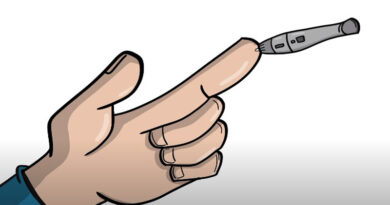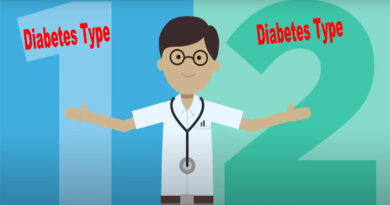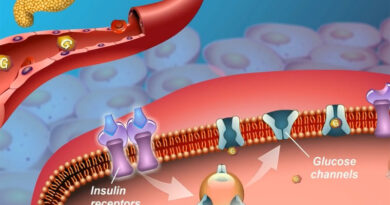Type 1 Diabetes
Last Update on September 19, 2022
| What is Type 1 diabetes? | Symptoms | Causes | Risk factors | Screening Tests | Treatments | Complications |
1. What is Type 1 diabetes?
Type 1 diabetes is a chronic disease also referred to as juvenile diabetes or insulin-dependent diabetes. The pancreas produces little or no insulin in this situation to control the blood sugar. Insulin is a hormone that is produced by the pancreas to maintain a normal level of sugar. The body uses insulin to let glucose (sugar) into cells where it can be used to make energy.
Type 1 diabetes is a disease in which your immune system kills the cells (beta cells) in your pancreas that produce insulin. Juvenile diabetes was the old name for type 1 diabetes because it is typically diagnosed in adolescents and teenagers.
Type 1 diabetes may be caused by a lots of factors, including genetics and some viruses. Type 1 diabetes can affect adults, though it often first appears in teens or children.
Similar to type 1, secondary diabetes occurs when your beta cells are destroyed by something else, such as a disease or damage to your pancreas, as distinct to your immune system.
After much research, there is currently no treatment for type 1 diabetes, The goal of treatment is to prevent problems by controlling blood sugar levels with the use of insulin, food, and lifestyle changes.
These two conditions differ from type 2 diabetes, in which your body does not react to insulin as normally should be reacting.
2. Symptoms of Type 1 Diabetes:
Although signs are frequently minor, they can develop. The symptoms are:
- Extreme thirst
- Increased hunger (especially after a meal)
- Dry mouth
- Upset stomach and vomiting
- Frequent urination
- Unexplained weight loss
- Fatigue
- Blurry vision
- Heavy, labored breathing
- Commonly infections of your skin, urinary tract, or vagina
- Crankiness or mood changes
- Bedwetting in a child
Emergency symptoms and signs:
- Shaking and confusion
- Rapid breathing rate
- Fruity smell to your breath
- Belly pain
- Loss of consciousness
3. Causes of Type 1 Diabetes:
A hormone called insulin supports the absorption of glucose, or sugar, into the tissues of your body. It works as fuel for your cells.
Type 1 diabetes affects beta cells, which inhibits the process of producing insulin in the pancreas. Due to a lack of insulin, glucose is unable to enter your cells. Instead, it accumulates in your blood, killing your cells. High blood sugar is brought on by this, which may cause:
- Dehydration: You urinate more when your blood sugar level is higher. That is how your body gets rid of it. Your body dries out because a lot of water leaves your body through urine.
- Weight loss: When you urine, glucose leaves your body and carries calories with it. Because of this, a lot of people with high blood sugar lose weight. Dehydration also causes it.
- Diabetic ketoacidosis (DKA): When your body runs out of glucose to use as fuel, it breaks down fat cells. The produced substances are referred to as ketones. To maintain the proper function of your body, your liver releases the sugar it has stored. But without insulin, your body can’t utilize it, so it develops in your blood along with the acidic ketones. Ketoacidosis, a condition marked by an excess of glucose, dehydration, and acid accumulation, can be fatal if untreated quickly.
- Damage to your organs: Your eyes, kidneys, and heart can become damaged with the passing of time with high blood sugar levels. They may also increase your risk of developing atherosclerosis, or narrowing of the arteries, which can result in heart attacks and strokes.
Type 1 diabetes cannot be stopped. Health experts are unaware of all the factors leading. But they are aware that your genes are involved.
Doctors are also aware that type 1 diabetes can develop when an outside factor, such as a virus, instructs your immune system to attack your pancreas. Autoantibodies, which are symptoms of this attack, are common in persons with type 1 diabetes. When their blood sugar is high, they are present in practically everyone who has the illness.
Other autoimmune disorders like Graves’ disease or vitiligo can co-occur with type 1 diabetes.
4. Risk factors of Type 1 Diabetes:
Type 1 diabetes affects just approximately 5% of people with diabetes. This type has equally affected both men and women. You have a greater chance of getting type 1 diabetes if you follow these:
- Are you under the age of 20
- Being white
- Have a type 1 person as a parent or sibling
5. Type 1 Diabetes Tests:
Your blood sugar levels will be checked by your doctor if they suspect you have type 1 diabetes. They might test for glucose or other substances which are produced by your body when your insulin levels are low in your urine.
Several blood tests can detect type 1 diabetes in children. These tests are used to both diagnose diabetes and evaluate treatment:
- Random blood sugar test: The main diagnostic test for type 1 diabetes is this one. At some random time, a blood sample is get for blood sugar tests.
- Glycated hemoglobin (A1C) test: This test shows the result of a three-month average blood sugar level in children.
- Fasting blood sugar test: In this test, a blood sample is taken when your child does not eat food for eight hours or overnight.
If a blood sugar test identifies diabetes in your bloodstream then your doctor could suggest further tests to identify between type 1 diabetes and type 2 diabetes if blood sugar testing reveals diabetes because the two conditions require different treatment approaches. Blood tests to look for antibodies, which are frequently found in type 1 diabetes, are additional tests.
6. Treatments of Type 1 Diabetes:
People with type 1 diabetes are able to lead active and healthy lives. It is necessary for you to monitor your blood sugar levels carefully. Your doctor will advise you of a range that the measurements should fall into. You may need to adjust your insulin intake, diet, and activity.
Type 1 diabetes is controlled with:
- Taking insulin
- Eating healthy foods
- Exercising regularly
You will regularly interact with your child’s diabetes care team, which consists of a qualified dietitian, certified diabetes care and education specialist, and health care provider. Maintaining your child’s blood sugar levels within a set range is the aim of treatment. This goal range aids in maintaining your child’s blood sugar as near normal as possible.
6.1. Insulin:
Your doctor will generally address three things when suggesting insulin:
- How quickly a medication lowers your blood sugar is referred to as its “onset.”
- When insulin is working the hardest to drop your blood sugar, this is known as “peak time.”
- Duration is how long it continues to function after it starts.
- Anyone with type 1 diabetes needs ongoing care with one or more insulin types to stay alive.
Rapid-acting insulin: This type of insulin begins to function to lowering blood sugar within 15 minutes. It lasts roughly 4 hours but its peak effect starts after 60 minutes. This type is frequently taken 15 to 20 minutes before to food. Rapid-acting insulin names are:
- Lispro (Humalog, Admelog)
- Aspart (NovoLog, Fiasp)
- Glulisine (Apidra)
Regular or Short-acting insulin: This type of insulin, is often called normal insulin. It starts to function about 30 minutes after injection. It reaches its full effect around 90 to 120 minutes and lasts between 4 and 6 hours. Short-acting insulin names are:
- Humulin R
- Novolin N
Intermediate-acting insulin: This type of insulin, also known as NPH insulin, starts to activate within one to three hours. It starts in full effect around 6 to 8 hours and lasts 12 to 24 hours. Intermediate-acting insulin names are:
- Humulin N
- Novolin N
Long- and ultra-long-acting insulin: This type of insulin may help protect for up to 14 to 40 hours. These types of insulin names are:
- Glargine (Lantus, Toujeo)
- Detemir (Levemir)
- Degludec (Tresiba)
Your doctor may recommend two shots of two different types of insulin to begin. You could need more shots in the future.
The majority of insulin is sold in vials, which are tiny glass bottles. You administer the shot to yourself using a fine needle and syringe with a needle on the end. Some of them are prefilled pens. One more is inhaled. Another way to acquire it is from an insulin pump, a device you wear that dispenses it through a tiny tube into your body. You can choose the type and delivery technique that are appropriate for you with the help of your doctor.
6.2. Eating healthy foods:
Additionally, you must comprehend how food affects your blood sugar. You may create a healthy eating plan that helps keep your levels where they should be once you understand the functions that protein, lipids, and carbohydrates play in your diet. You can get started with assistance from a licensed dietitian or diabetic educator.
Although food plays a major role in the treatment of diabetes, your child does not need to adhere to a rigorous “diabetic diet.” Your child’s diet should frequently include items that are high in nutrition and low in fat and calories, just like the rest of the family, like:
- Vegetables
- Fruits
- Lean protein
- Whole grains
6.3. Exercising regularly:
Exercise is essential in the treatment of type 1 diabetes. However, it’s not as easy as going for a run. Your blood sugar levels will change after exercise. Therefore, you must balance your insulin dosage and your diet when engaging in any activity, even simple household or gardening chores.
7. Complications of Type 1 Diabetes:
If type 1 diabetes is not effectively controlled, it can cause other issues. The complication factors are:
Cardiovascular disease: You are more likely to develop blood clots, high blood pressure, and high cholesterol if you have diabetes. These may result in cardiac failure, a heart attack, a stroke, or chest pain.
- Skin problems: Bacterial or fungal infections are more common in diabetics. Blisters or rashes may also result from diabetes.
- Gum disease: Too much plaque, little saliva, and poor blood flow can all result in oral health issues.
- Pregnancy problems: Preeclampsia, early delivery, birth abnormalities, stillbirth, and type 1 diabetes are all more common in women.
- Retinopathy: About 80% of persons with type 1 diabetes for more than 15 years of experience with this eye condition. No of how long you’ve had the sickness, it’s uncommon before adolescence. Maintain proper control of your blood sugar, blood pressure, cholesterol, and triglycerides to prevent them and preserve your vision.
- Kidney damage: Nephropathy affects 20% to 30% of individuals with type 1 diabetes. Over time, the chances rise. It usually appears 15 to 25 years after diabetes first appears. Other severe issues like kidney failure and heart disease can result from diabetes.
- Poor blood flow and nerve damage: A lack of blood flow to your feet and a loss of feeling is caused by damaged nerves and hardened arteries. This increases your risk of getting hurt and hinders the healing of open wounds and sores. If it occurs, you can lose a limb. Additionally, nerve damage may lead to digestive issues including nausea, vomiting, and diarrhea.



